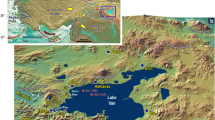Abstract
The Aurora volcanic field, located along the northeastern margin of Mono Lake in the Western Great Basin, has erupted a diverse suite of high-K and shoshonitic lava types, with 48 to 76 wt% SiO2, over the last 3.6 million years. There is no correlation between the age and composition of the lavas. Three-quarters of the volcanic field consists of evolved (<4 wt% MgO) basaltic andesite and andesite lava cones and flows, the majority of which contain sparse, euhedral phenocrysts that are normally zoned; there is no evidence of mixed, hybrid magmas. The average eruption rate over this time period was ∼200 m3/km2/year, which is typical of continental arcs and an order of magnitude lower than that for the slow-spreading mid-Atlantic ridge. All of the Aurora lavas display a trace-element signature common to subduction-related magmas, as exemplified by Ba/Nb ratios between 52 and 151. Pre-eruptive water contents ranged from 1.5 wt% in plagioclase-rich two-pyroxene andesites to ∼6 wt% in a single hornblende lamprophyre and several biotite-hornblende andesites. Calculated oxygen fugacities fall within –0.4 and +2.4 log units of the Ni-NiO buffer. The Aurora potassic suite follows a classic, calc-alkaline trend in a plot of FeOT/MgO vs SiO2 and displays linear decreasing trends in FeOT and TiO2 with SiO2 content, suggesting a prominent role for Fe-Ti oxides during differentiation. However, development of the calc-alkaline trend through fractional crystallization of titanomagnetite would have caused the residual liquid to become so depleted in ferric iron that its oxygen fugacity would have fallen several log units below that of the Ni-NiO buffer. Nor can fractionation of hornblende be invoked, since it has the same effect as titanomagnetite in depleting the residual liquid in ferric iron, together with a thermal stability limit that is lower than the eruption temperatures of several andesites (∼1040–1080°C; derived from two-pyroxene thermometry). Unless some progressive oxidation process occurs, fractionation of titanomagnetite or hornblende cannot explain a calc-alkaline trend in which all erupted lavas have oxygen fugacites ≥ the Ni-NiO buffer. In contrast to fractional crystallization, closed-system equilibrium crystallization will produce residual liquids with an oxygen fugacity that is similar to that of the initial melt. However, the eruption of nearly aphryic lavas argues against tapping from a magma chamber during equilibrium crystallization, a process that requires crystals to remain in contact with the liquid. A preferred model involves the accumulation of basaltic magmas at the mantle-crust interface, which solidify and are later remelted during repeated intrusion of basalt. As an end-member case, closed-system equilibrium crystallization of a basalt, followed by equilibrium partial melting of the gabbro will produce a calc-alkaline evolved liquid (namely, high SiO2 and low FeOT/MgO) with a relative f O 2 (corrected for the effect of changing temperature) that is similar to that of the initial basalt. Differentiation of the Aurora magmas by repeated partial melting of previous underplates in the lower crust rather than by crystal fractionation in large, stable magma chambers is consistent with the low eruption rate at the Aurora volcanic field.
Similar content being viewed by others
Author information
Authors and Affiliations
Additional information
Received: 7 July 1995 / Accepted: 19 April 1996
Rights and permissions
About this article
Cite this article
Lange, R., Carmichael, I. The Aurora volcanic field, California-Nevada: oxygen fugacity constraints on the development of andesitic magma. Contrib Mineral Petrol 125, 167–185 (1996). https://doi.org/10.1007/s004100050214
Issue Date:
DOI: https://doi.org/10.1007/s004100050214




